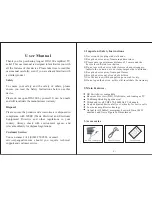
Geophysical Survey Systems, Inc.
GS Series
200 HS Antenna
MN27-151 Rev A
1
Introduction
Thank you for purchasing one of GSSI’s GS (Geophysical Survey) Series lower frequency antennas. The
GS antennas represent the state-of-the-art for GPR applications that require the deepest possible
penetration while maintaining the fine resolution you’ve come to expect from GSSI mid and high
frequency systems. GS antennas incorporate GSSI’s HyperStacking
®
(HS) technology for blazingly fast
collection speed and high levels of noise immunity. The GS has been designed with real-life field
conditions in mind. This is a system that you can confidently take to the ends of the Earth and use in the
harshest environments. Here at GSSI we’re very proud of what we’ve created and even prouder that
you’ve decided to place your trust in us.
What Comes in the Box
•
200 HS Antenna
•
HS Module
•
Lithium-ion Batteries (2)
•
Dual Bay Battery Charger
•
Tow Handle
•
GS Series Manual
•
Panasonic G1 Tablet (optional)
•
SIR 4000 WiFi Module (optional)
A Note about HyperStacking Technology
The GPR data you see on the screen start as received pulses of electromagnetic energy that have reflected
off objects or interfaces in the ground. The reflected signals generate electrical charges in the receive
antenna element that are digitized by the antenna’s onboard sampler. They are then converted into digital
values and displayed as a colorized linescan profile or an oscilloscope trace. Traditional GPR systems
send out one pulse at a time and record one small piece of reflected information (a sample) from that one
pulse. It takes many samples to make a single scan and many scans to make a profile.
HyperStacking (HS for short) technology represents a generational leap in GPR. HS antennas record
many samples from a single pulse. This allows an HS antenna to record data at speeds up to an order of
magnitude faster than conventional systems. In practice, the HS antennas use that extra data to average, or
stack, individual samples. This helps to reduce the random noise present in the signal and results in
cleaner and deeper data.
An added benefit is that we randomize the timing of the transmit pulse. This is called “dithering” and
means that we automatically average out manmade noise from nearby radio transmitters. This patented
technique enables you to work more confidently in high-noise environments like urban areas or airports.
About this Manual
This document provides important information for operating the GS Series antenna and collecting,
reviewing, and transferring GPR data to a PC. It is available for free download at
. This manual is not necessarily a substitute for a full training class. Purchase of a
GS Series system includes complimentary access to GSSI’s regularly scheduled curriculum of
professionally led training classes. We encourage you to take advantage of the opportunities for
instruction and networking with other professionals. Please visit
or contact
Содержание 200 HS
Страница 1: ...MN27 151 Rev A ...
Страница 4: ...Geophysical Survey Systems Inc GS Series 200 HS Antenna ...
Страница 6: ...Geophysical Survey Systems Inc GS Series 200 HS Antenna ...
Страница 32: ...Geophysical Survey Systems Inc GS Series 200 HS Antenna MN27 151 Rev A 26 ...
Страница 33: ...Geophysical Survey Systems Inc GS Series 200 HS Antenna Notes ...
Страница 34: ......
Страница 35: ......








































